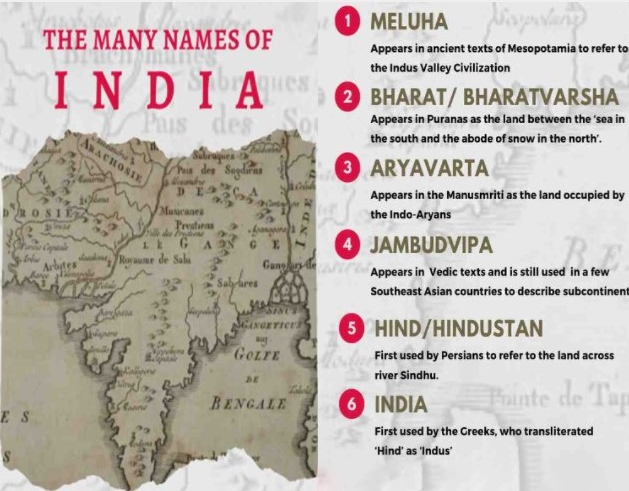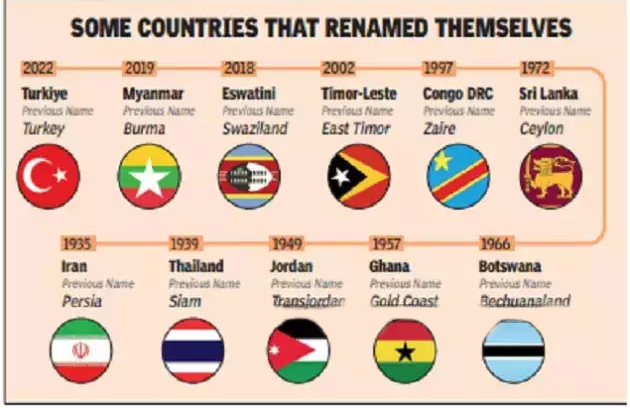Indian Polity
The Name Game: Bharat vs India
This editorial is based on India, Bharat and a Host of Implications which was published in The Hindu on 07/09/2023. It talks about the historical, ideological, constitutional, and international implications of the names Bharat and India, and how their use has political implications.
For Prelims: 58th Amendment, Article 1(1), Constituent Assembly, India's official languages
For Mains: Historical Background/History Associated with “Bharat” & “India, Balance between “India” and “Bharat”
"Bharat" is a historical and ideological name for India, while "India" is a constitutional and international name. The use of these names has become political due to the formation of an opposition alliance called INDIA (Indian National Developmental Inclusive Alliance).
Recently, the current government under Prime Minister Narendra Modi has used the term "President of Bharat" instead of "President of India" on an invitation card for the recent G-20 Summit. This shift in terminology has raised eyebrows and suggests a political dimension to the use of these names.
What is the Historical Background/History Associated with “Bharat” & “India”?
- Origins of the Names: The words "India" and its variants, such as "Hind" in Arabic, have foreign origins. These names were historically used by outsiders to refer to the land south and east of the Indus or Sindhu River.
- Historical Usage: During Afghan and Mughal rule, the term "Hindustan" was often used to refer to the northern regions of the Indian subcontinent.
- Later, European colonial powers, particularly the British, used "India" to describe not only the northern region but also the entire subcontinent. For them, it was primarily a geographical designation.
- Indian Renaissance and Nationalism: The Indian Renaissance played a crucial role in shaping the consciousness that all the people in the Indian subcontinent constituted a single nation. Some promoters of this movement sought to find ancient roots for Indian nationalism and believed that using a name given by foreigners was unacceptable.
- They preferred the term "Bharat" and its variations in different languages.
- Name Controversy: The Muslim League, led by Muhammad Ali Jinnah, raised concerns over the use of the name "India" for the newly independent nation. They argued that "India" should be associated with the Hindu-majority regions, while the Muslim-majority areas should be recognized as a separate nation, Pakistan.
- This name dispute reflected the deep-seated religious and political divisions during the partition.
- Syncretic Word - "Hind": Figures like Netaji Subhas Chandra Bose advocated for a syncretic word, "Hind," which could be acceptable to a wide range of people, including those from different faiths.
- "Hind" is still in use today, and expressions like "Jai Hind" reflect its enduring significance in Indian culture.
How “Bharat” and “India” are Balanced?
- Adoption of the Constitution: The Indian Constitution was originally adopted by the Constituent Assembly in English. This underscores the historical and legal importance of the English version as the foundational text of the Constitution.
- Publication of a Hindi Translation: In addition to the English version, a Hindi translation of the Constitution was published in 1950. This translation was signed by the members of the Constituent Assembly, and it was done in accordance with a resolution passed by the Constituent Assembly.
- Official Status of Both Versions: The presence of both English and Hindi versions of the Constitution underscores their official status within the Indian legal framework.
- It highlights the importance of providing access to the Constitution in both of India's official languages, English and Hindi.
- Constitutional Amendments: The 58th Amendment to the Constitution in 1987 likely addressed issues related to the use of Hindi and English in official documents, legal proceedings, and government communications.
- The 58th Amendment gave the President the power to publish the official text of the Constitution in Hindi, which could also be used in legal proceedings.
- Article 1(1): Article 1(1) of the Constitution defines the name and character of the country. In the English version, it states "India, that is Bharat, shall be a Union of States," emphasizing "India" as the primary name.
- In the Hindi version, it reads "Bharat artharth India, rajyon ka sangh hoga," with "Bharat" given prominence.
- Examples of Names: Examples such as the "Gazette of India" in English and "Bharat ka Rajpatra" in Hindi are given to illustrate how this naming convention is applied to various official publications.
- The choice of names reflects the dual-language nature of India's official documents and publications.
Some of the Other Countries that Changed their Name
- Siam to Thailand (1939):
- The country changed its name to assert its unity and identity against Western colonial influence in Southeast Asia. The new name, "Thailand," means "Land of the Free" and emphasises the country's independence and national pride.
- Zaire to the Democratic Republic of the Congo (1997):
- The country changed its name to distance itself from the authoritarian rule of Mobutu Sese Seko (dictator who ruled for over 3 decades). The new name emphasised the return to a democratic system of governance.
- East Pakistan to Bangladesh (1971):
- In 1971, East Pakistan became independent from West Pakistan after a violent war, forming the new country of Bangladesh. This marked the end of the Bangladesh Liberation War and represented the cultural, linguistic, and political distinctions between the two regions.
- In 2022, Turkey changed its name to Türkiye, as the name signifies the best representation and expression of the Turkish people’s culture, civilization and values.
What is the Current Scenario?
- Use of "India" Internationally: India has consistently used the name "India" in all international and multilateral fora. This signifies that the country's international identity and recognition are associated with the name "India”.
- This highlights the practicality and standardisation of using the English name "India" in global diplomacy and communication.
- Recent Example with Greece: The reference to the Joint Statement issued during the Prime Minister's visit to Greece serves as a contemporary example. The document is titled "India-Greece Joint Statement," emphasising the use of "India" in official bilateral relations.
- Dual-Language Approach: It is noted that India follows a dual-language approach in official documents and diplomatic contexts. Under the National emblem in letters of credence given by the President of India to Ambassadors-designate, the words "Rashtrapati" and "Bharat Gantantra" are written in Hindi, while the English equivalents, "President" and "Republic of India," are used underneath.
- This approach reflects India's commitment to multilingualism and its diverse linguistic heritage.
- Modern Usage: The use of both "Jai Hind" and "Jai Bharat" is noted in contemporary India, reflecting the coexistence of different cultural and linguistic traditions. For instance, in most of the major speeches, such as the Independence Day speech both expressions are used, signifying a recognition of the diverse historical and cultural threads that make up the fabric of the nation.
Note:
- In 2015, the Centre opposed a name change, stating that the issue had been extensively deliberated upon during the Constitution's drafting.
- The Supreme Court has twice rejected pleas to rename 'India' to 'Bharat', once in 2016 and then in 2020, reaffirming that "Bharat" and "India" both find mention in the Constitution.
Conclusion
Such a change could alienate parts of the country that prefer the name "India" to "Bharat." Public sentiment and regional preferences regarding the country's name are diverse and should be considered in any decision. Any departure from this tradition could have cultural and identity implications. The tradition of using "India" in English and "Bharat" in Hindi, reflecting India's linguistic diversity, is considered both wise and constitutionally correct. The question raised is whether changing this tradition to prioritise one term over the other should be a priority at this time when the country is facing other challenges (Unemployment, Environmental Degradation, Poverty, Healthcare, Inequality, Gender Discrimination, etc.).
Legal Insights
|
Drishti Mains Question: In light of recent debates and legal decisions, critically evaluate the significance and implications of maintaining the dual-language approach to naming the country. Provide insights into the challenges and considerations associated with any potential change in this tradition. |






